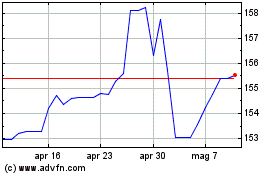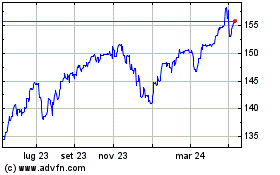Australian Dollar Rises As Asian Stock Markets Traded Higher
10 Luglio 2017 - 3:53AM
RTTF2
The Australian dollar strengthened against other major
currencies in the Asian session on Monday, as Asian stock markets
traded higher following the positive cues from Wall Street on
better-than-expected U.S. jobs data and also data showed that
China's inflation held steady in June. Crude oil rose in Asian
trades after tumbling on Friday.
Data from the National Bureau of Statistics showed that the
consumer prices in China were up 1.5 percent on year in June. That
was unchanged from the May reading, although it was shy of
expectations for 1.6 percent.
On a monthly basis, inflation fell 0.2 percent after easing 0.1
percent in May.
The bureau also said that producer prices were up 5.5 percent on
year, unchanged and also in line with expectations.
Crude oil delivery for August is currently up by 0.36 percent or
$44.59 per barrel. Meanwhile, the crude oil futures tumbled Friday,
extending weekly losses amid lingering concerns about the global
supply glut.
In the Asian trading, the Australian dollar rose to a 6-day high
of 86.92 against the yen and a 4-day high of 1.0468 against the NZ
dollar, from Friday's closing quotes of 86.60 and 1.0443,
respectively. If the aussie extends its uptrend, it is likely to
find resistance around 88.00 against the yen and 1.06 against the
kiwi.
Against the U.S. dollar, the euro and the Canadian dollar, the
aussie advanced to 0.7615, 1.4977 and 0.9808 from last week's
closing quotes of 0.7603, 1.4989 and 0.9790, respectively. The
aussie may test resistance around 0.77 against the greenback, 1.47
against the euro and 1.00 against the loonie.
Meanwhile, the Japanese yen weakened against other major
currencies amid risk appetite.
In economic news, the Cabinet Office said that core machine
orders in Japan skidded a seasonally adjusted 3.6 percent on month
in May, coming in at 805.5 billion yen. That missed forecasts for
an increase of 1.7 percent following the 3.1 percent decline in
April.
Japan posted a current account surplus of 1,653.9 billion yen in
May. That missed forecasts for 1,792.8 billion yen following the
1,951.9 billion yen surplus in April. The trade balance showed a
deficit of 115.1 billion yen, missing expectations for a shortfall
of 45.0 billion yen and down from the 553.6 billion yen surplus in
the previous month.
The Bank of Japan said that overall bank lending in Japan was up
3.3 percent on year in June, standing at 513.772 trillion yen. That
exceeded expectations for a gain of 3.2 percent, which would have
been unchanged from the May reading.
The yen fell to near 1-1/2-year lows of 130.27 against the euro
and 118.48 against the Swiss franc, from Friday's closing quotes of
129.85 and 118.11, respectively. If the yen extends its downtrend,
it is likely to find support around 132.00 against the euro and
119.00 against the franc.
Against the U.S. and the New Zealand dollars, the yen dropped to
a 2-month low of 114.20 and nearly a 5-1/1-month low of 83.07, from
last week's closing quotes of 113.90 and 82.89, respectively. The
yen is likely to find support around 115.00 against the greenback
and 84.00 against the kiwi.
Against the pound and the Canadian dollar, the yen edged down to
147.29 and 88.67 from Friday's closing quotes of 146.77 and 88.43,
respectively. On the downside, 148.00 against the pound and 89.00
against the loonie are seen as the next support levels for the
yen.
Looking ahead, the German trade data for May is due to be
released in the pre-European session at 2.00 am ET.
At 4.30 am ET, Eurozone Sentix investor confidence index for
July is set to be published.
In the New York session, U.S. labor market conditions index for
June and U.S. consumer credit for May are slated for release.
Grafico Cross US Dollar vs Yen (FX:USDJPY)
Da Mar 2024 a Apr 2024

Grafico Cross US Dollar vs Yen (FX:USDJPY)
Da Apr 2023 a Apr 2024
